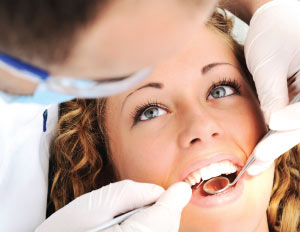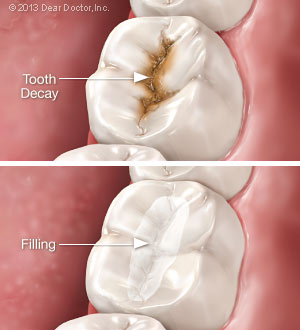Cost-Saving Treatment Alternatives
Interim Solutions For Treating Dental Disease
Dear Doctor,
I've had limited employment for the last two years and I need a significant amount of dental work, but I'm afraid that I just cant afford it. Do you have any suggestions?

Dear Chris,
A lot can be done to manage dental disease in both a cost-conscious and cost-effective way that will preserve teeth and ensure dental health until you can afford longer-term treatment.
Most anyone would agree that something is better than nothing and this is especially true with dental healthcare. We also understand that when times are tough economically, people are just as concerned with saving money as saving their teeth. Although many may feel they have no choice but to put off necessary dental work, there is more that can be done than meets the eye. Additionally, putting off necessary or interceptive treatment may make the situation worse and more costly down the road.
Although many may feel they have no choice but to put off necessary dental work, there is more that can be done than meets the eye.
With limited resources, attention should be directed to best serve each individual's risk. Your dentist will start with a thorough examination and diagnosis to establish your particular susceptibility to dental disease. This is important because: some individuals are more prone to decay or have dietary or other sources of acid present in the mouth that can cause tooth erosion; others are at greater risk for periodontal (gum) disease; and some have functional or bite-related issues.
It's treating tooth decay and restoring your teeth that generally start to get expensive. So here's a good health promoting and cost-effective strategy to follow:
1. Assessing Risk.
It's important to change the conditions that lead to tooth decay in the first place in order to change your risk of infection. Based on known science, modern dentistry can easily and quickly assess your personal risk for tooth decay by using a system known as Caries Management By Risk Assessment (CAMBRA).* This includes sampling saliva to get an immediate readout of the level of the bacterial activity responsible for tooth decay. Personalized measures can then be recommended that you should take at home as part of a daily oral/dental health regimen to arrest and prevent decay, also known as dental caries.
2. Promoting Health.
Are you properly removing the bacterial biofilm (plaque) that causes tooth decay (and gum disease for that matter) from your teeth? Is your diet conducive to oral as well as general health? Are you using fluoride toothpaste?
Almost everyone can benefit from a demonstration of good oral hygiene techniques and a professional teeth cleaning, to begin to control gum disease and set the stage for a healthier mouth. This service is important yet inexpensive.
Ensuring your mouth is moist and not dry is also important; healthy saliva flow counters acidity, helping to prevent tooth decay and erosion. Once your risk has been lowered, removing decay from your teeth and restoring them will yield longer-lasting results.
If your dentist finds that many teeth need to be restored, need root canal treatment, or extraction — or you have other oral care needs — less expensive solutions are available as follows:
3. Restoring Teeth Temporarily
 |
| Tooth decay can be removed and the tooth repaired with a fluoride-releasing filling that is less expensive than traditional fillings. |
Emergency needs such as painful or abscessed teeth must be treated first; unsalvageable teeth may need to be extracted. Your dentist can then remove areas of decay in teeth that can indeed be saved, and restore them with some of the newer, less expensive and longer-lasting tooth restoration materials. For example, fast-setting, high-strength Glass Ionomer Cement (GIC) restorations and Resin Bonded Glass Ionomers (RBGI) are particularly useful for the restoration of decayed tooth surfaces in low-stress (non-biting) areas.
While these tooth-colored, fluoride-releasing materials may not last as long as more permanent fillings, they may last for a number of years and also prevent further decay. Your dentist might also suggest you use a fluoride solution (available either over-the-counter or by prescription) that can either be applied to your teeth in special trays once or twice per day in five-minute applications, or brushed on. This will repair and strengthen the teeth, making them less susceptible to decay.
4. Managing Costs With Innovative Strategies
Most dentists will work with you; they want you to be healthy as much as you do. They are generally willing to spread payments out over time if you ask them to, especially when a lot of work is necessary. The payment plan should mirror your needs, dealing with emergencies first, including restoring the most severely decayed teeth, followed by restoring the less affected teeth, as funds become available. Your dentist will generally be able to provide enough time to restore most or all of the affected teeth in fewer but longer appointments, which will also make the treatment more feasible economically.
5. Setting Up Long-Term Goals
All of these proposals and suggestions should be part of a strategy to get you to the best possible long-term oral health. Hopefully when you are feeling less economically stressed and your finances are more in tune with your dental needs, you will be able to afford optimum dental care. This might include composite tooth-colored fillings, all-ceramic (porcelain) tooth-colored veneers and crowns to improve appearance, and/or metal-containing (gold) crowns for strength and wear-resistance that have a greater potential for long-term service.
We sincerely hope that this approach will provide a path forward to dental health and relieve your stress, both emotional and financial.





